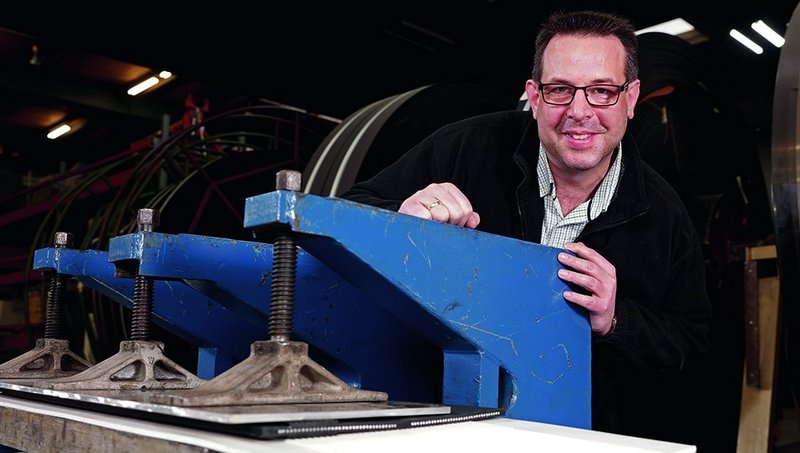Expertise in Rubber Takes to the Waterways
- ContiTech conveyor belt material is used to seal concrete seams in canal locks.
Hanover, Germany, August 2017. From canals to navigable rivers, waterways have been used for transportation since the Middle Stone Age (approx. 9,600 B.C.). In northern Europe, major river systems were indeed the main means of transport for many centuries, both for heavy loads and for passengers. The first human-made waterways in the region were probably in the provinces of the Roman Empire. Construction of the first canals in Asia and Northern Africa began during the reign of Pharaoh Necho II, who ruled from 610 to 595 B.C. In Egypt, the Nile and Mediterranean were linked to the Red Sea by a waterway that was in many ways an early geographic precursor of today’s Suez Canal. According to the geographers of antiquity, it had locks at either end. Canal locks were first invented back in 984 A.D., by Qiao Weiyue, assistant commissioner for transport in Huaina, China. Until then, slipways and ramps had been used to overcome differences in water level, but these often left vessels damaged and loads vulnerable to theft. They were also dogged by problems of drought. To resolve the situation, Qiao Weijue had two suspended gates fitted with a distance of 50 paces (76 m) between them. He then had the intervening stretch of water roofed over and the banks shored up to create a lock. Each lock could effect a change in water level of between 1.2 and 1.5 meters.
In 1325 A.D., the invention of the pound lock finally prompted the construction of the great canal systems of central Europe. Later, between 1700 and 1850, Europe’s rivers were systematically controlled, and safe, peaceful, managed waters were soon the preferred route of travel rather than natural rivers, with their strong currents, silt accumulations and dangerous banks.
Today, the worldwide inland canal network has a combined length of about 600,000 kilometers. Locks and lock systems with one or more chambers allow vessels to overcome water level differences of up to 25 meters. Upstream and downstream waters are controlled by opening and closing two watertight gates: When a vessel has entered the chamber, the gates are closed and water is allowed in or out, raising or lowering the water level to that of the next stretch of water.
Positive deployment in the field
Germany’s waterway network consists of 7,300 kilometers of inland and 23,000 square kilometers of maritime waterways. They are used by ever-increasing numbers of vessels that transport people and goods. But for growth of this kind to be safe and reliable, a fully functional infrastructure is needed. Siphon structures, bridges, barrages, ship lifts and locks must all be maintained and upgraded every few years. At present, about 30 percent of the country’s 315 locks are in need of repairs, conversions or maintenance, having reached the end of their useful lives, in theory at least – and in some instances even exceeded it. Last May, for example, the north chamber of the lock at Kleinostheim on the River Main required a complete overhaul, with a thorough upgrade and new seals. It was the first time the joints had been modernized for many years.
On this project, Germany’s Federal Waterways Engineering and Research Institute opted for the product of a joint research effort with ContiTech. “The materials ContiTech uses in its conveyor belts are already being utilized successfully in rubber dams and have proven to be extremely resilient, among other things. They are even able to withstand deliberate acts of vandalism,” explains Michael Möschen, application technician with ContiTech. Together, the research team road-tested a new sealing method for lock basins to find out how an existing lock might be retrofitted with extra-durable seals.
Unlike continuous structures, the walls of a lock consist of several sections. Between them, expansion and sealing joints give the concrete the space it needs to expand on hot days without damaging the canal wall with the pressure they exert. At Kleinostheim, the joints were originally sealed with PVC to prevent water from permeating them. After fifty years, however, the profile seals are now crumbling, and water is entering the basin from both the River Main and the adjacent lock chamber.
Back in 2010, as part of a pilot project with the Federal Waterways Engineering and Research Institute, ContiTech floated the idea of using a strip of natural rubber. The suggestion was to use a hoisting belt with a steel cord-traction member, much like those used to raise and lower bodies-in-white on the production lines of automotive manufacturers. In three stages of development, different profiles were tested and a series of complex lab trials was carried out on joints simulated in a concrete model in the halls of the Federal Waterways Engineering and Research Institute. When the time came to pilot the solution in Kleinostheim, the team laid the belt along a joint in the pump tunnel, bolted down the sides and then covered the fixture-points with protective plates.
“After about five years in operation, our conveyor belt material has lasted very well and proven that it’s simply perfect for this kind of work,” says Michael Möschen. “Last year,” he adds, “we went into the next stage of construction and further optimized our process. Together with the Federal Waterways Engineering and Research Institute, we aim to make this solution for sealing lock joints a standard construction technique.”
Fewer major construction sites
The new, enhanced method of maintaining lock joints with ContiTech conveyor belts means work can be carried out while the lock is in operation with a full basin of water. It must be drained only very briefly to provide access to the bed. “Lock chambers only need to be laid dry for a short while so that our workers and technicians can install the natural rubber belts. This tends to take no more than two weeks – which saves both time and money,” Möschen adds. Being especially durable, the rubber belt will mean fewer major construction sites in the future, as locks will require less frequent maintenance. “As conveyor belt specialists, we are always looking into new uses for our products and materials – even if they are far removed from the usual world of mining. Using them to seal joints in locks has taken us into uncharted waters, so we now have to wait and see if this method catches on. After about five years in use, the system we have just set up will be checked over, and if it is recognized as meeting all the standards, then we offer a viable solution for repairing joints in all locks,” Möschen sums up.

Wolfgang Reinert
Head of Media & Public Relations
ContiTech



